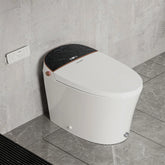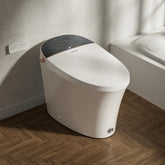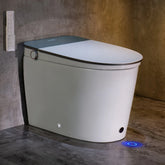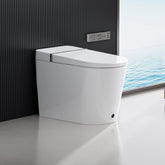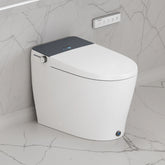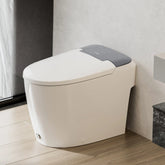🌿 How Much Water Can a Smart Toilet Save? Real Data & Long-Term Environmental Benefits

Modern smart toilets are not only a symbol of high-quality living but also an important solution for water conservation and environmental protection. For decades, traditional toilets in the U.S. have consumed large amounts of water per flush. Today’s high-efficiency smart toilets use only a fraction of that water. Every household can achieve significant daily water savings simply by upgrading their toilets.
🚽 Traditional Toilets vs Smart Toilets:
Water Usage Differences
In the past, older toilets in the U.S. used up to 3.5 gallons per flush (GPF). Even after the 1994 federal standard limited flush volume to 1.6 GPF, many homes still have older models.
In contrast, modern smart toilets come with built-in tanks and dual flush systems, using 1.0 GPF for light flush and 1.28 GPF for full flush. Users can choose flush volume based on need, further minimizing water waste.
💧 Annual Water Usage Comparison for a Family of Four
Assuming each person flushes 5 times a day (3 full flushes + 2 light flushes):
| Toilet Type | Flush Volume (GPF) | Estimated Annual Water Usage | Annual Water Saved |
|---|---|---|---|
| Oldest Models (3.5 GPF) | 3.5 | 33,550 gallons | Over 25,000 gallons |
| Older Models (1.6 GPF) | 1.6 | 11,680 gallons | — |
| Smart Toilets (1.0 / 1.28 GPF) | Average ~1.14 | 8,322 gallons | About 3,300 gallons |
💧 What Does Saving 3,300 Gallons Mean?
- Equivalent to about 12 tons of fresh water
- Enough to fill over 50 standard bathtubs
- Equal to more than 6 months of daily showers for one person
- Sufficient for a family’s entire yearly dishwashing water use
Every flush reduces the strain on rivers, groundwater, and municipal water systems.
🌱 Long-Term Environmental Benefits
- Over a 20-year lifespan, smart toilets save about 66,000 gallons compared to 1.6 GPF models.
- If replacing the oldest 3.5 GPF toilets, total savings can exceed 500,000 gallons per household.
- This reduces the burden on municipal water supply and wastewater treatment and cuts energy consumption, benefiting ecosystems and communities.
🌎 Why This Matters
Freshwater is one of Earth’s most precious resources. Western and southern U.S. regions face chronic drought and water shortages. Sustainable water use has become a responsibility every household must embrace. High-efficiency smart toilets are becoming a crucial part of responsible water management.
Choosing a smart toilet is not only about comfort and convenience but also about a lifestyle that respects the environment and future generations.
✅ Recommended High-Efficiency Smart Toilets
-
TOTO Neorest® 700H
Dual flush: 0.8 / 1.0 GPF
Features: Ewater+ electrolyzed water automatic cleaning, auto open/close lid, heated seat, warm air dryer, ADA compliant, WaterSense certified, Top-tier flagship with ultimate water savings and hygiene experience. -
Kohler Veil® Smart One-Piece Toilet
Dual flush: 0.8 / 1.28 GPF
Features: Compact tankless design, auto open/close, heated seat, touchless flush
Compact and elegant, perfect for modern homes. -
Casta Diva CD-K030PRO Smart Toilet
Dual flush: 1.0 / 1.28 GPF
Features: Four-season constant temperature technology, multi-point full-zone sensor seat, warm water wash, warm air dryer, deodorizer, auto lid open/close, foot sensor flush, Combines advanced smart features with excellent water-saving performance, offering comfort year-round.
✅ Summary
Small daily changes add up to massive positive impacts over time. Smart toilets perfectly integrate comfort, hygiene, and water savings, helping every household reduce environmental pressure significantly. Whether you choose TOTO Neorest®, Kohler Veil®, or CD-K030PRO, upgrading your toilet is a responsible environmental choice — starting with every flush.
